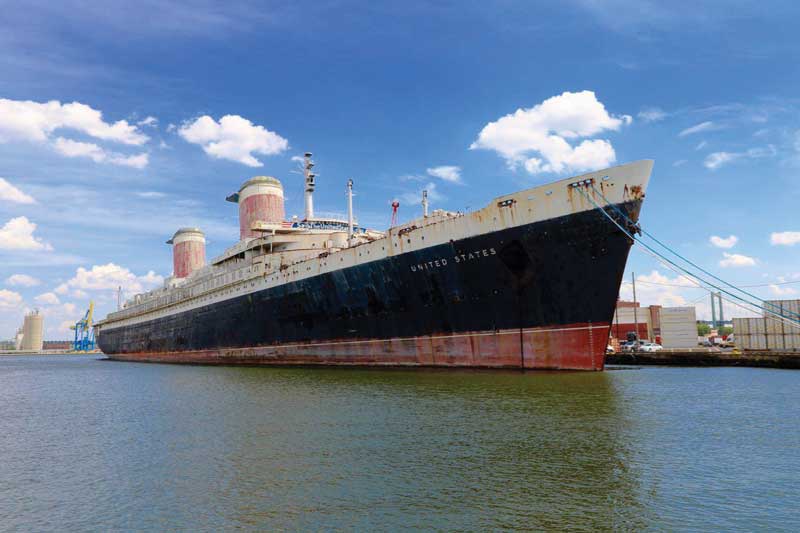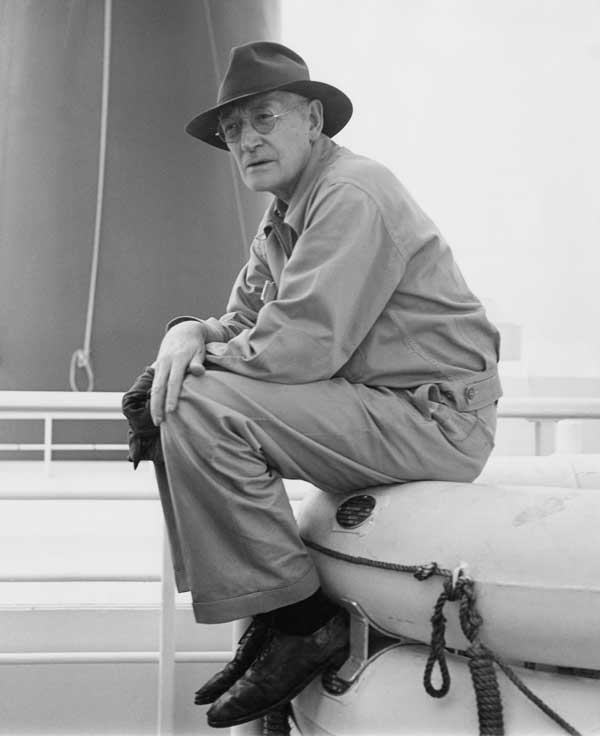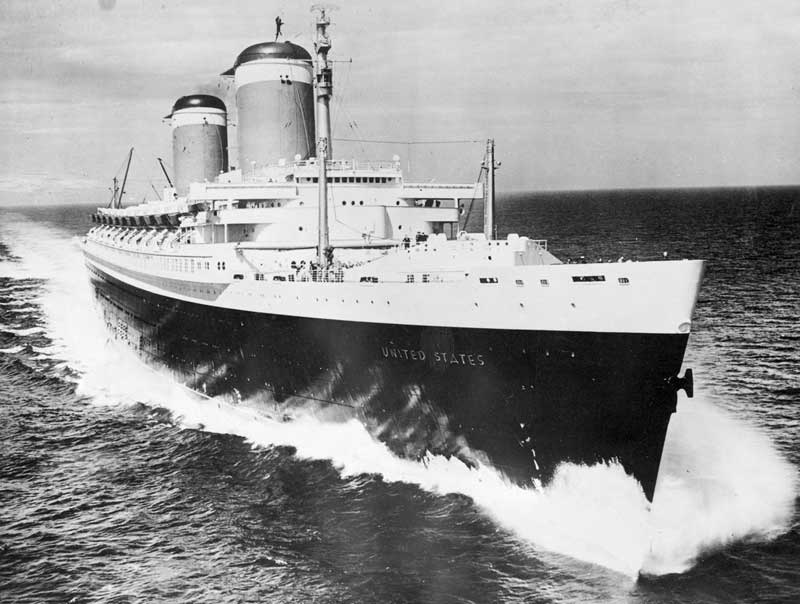Some PropTalk readers may recall the littoral combat ships that have visited the Bay—Freedom and Sioux City. The littoral combat ships are designed for operations near shore, envisioned to be a networked, agile, stealthy surface combatant capable of moving at 45 knots.

The design firm responsible for the monohull variant of the littoral combat ships is Gibbs and Cox, a naval architecture firm founded by William Francis Gibbs, and the employer of many avid boaters on the Bay.
The great grandfather of the littoral combat ships was the SS United States. The story of the SS United States is also the story of a brilliant marine engineer and naval architect who brought her into being.
To say that William Francis Gibbs had a long-running love affair with a ship would be, quite frankly, an understatement. Salty-tongued, superstitious, and with no formal training in the field, he quit his job in real-estate law in 1916 to devote himself to designing the world’s fastest ship. He passionately—and secretly—read the latest professional journals and observed the largest and fastest ships of the day. Eventually, J.P. Morgan, Jr., one of the directors of the International Mercantile Marine (IMM), after only one meeting with William Francis Gibbs and his brother Frederic, offered to finance the construction of their two liners. Within a year, however, the nation’s entry into World War One derailed their plans.
With the end of the war Gibbs’s plans were revived. The U.S. government realized the value of having luxury liners that could be converted into troop ships, as the Queen Mary and Queen Elizabeth had done during the war. When the military conflict in Korea escalated in the late 1940s, the US government agreed to subsidize a large part of the new liner’s cost and operating expenses, with the understanding that it could be requisitioned for military purposes.
The ship’s keel was laid on February 8, 1950 at the Newport News Shipbuilding and Dry Dock Company, one of the most well-respected shipyards on the East Coast with a long history of contracts with the U.S. Navy. The ship that would become known as the SS United States became the first major liner to be built in a dry dock, which both simplified the construction process and facilitated William Francis Gibbs’s obsession with secrecy.

The low and graceful superstructure was built entirely of aluminum, which gave the ship a dead weight of 45,400 long tons, compared to the 77,000 long tons for the similarly sized Cunard Queens. Gibbs took every effort to keep the ship as light as possible, using two funnels or stacks regardless of the common perception of four funnels representing size and power. Her lighter weight allowed her to take full advantage of the astonishing 250,000 horsepower reportedly produced by her turbines. The exact maximum horsepower of her eight boilers remains a mystery to this date. Unusually, all of her engine spaces were complete on her launch, thanks both to being built in a dry dock and Gibbs’s introduction of modular construction, which cut down the construction time to 16 months. More than 3100 shipyard workers took the project from keel laying to delivery date in an astounding two years and three months.
Secrecy was tight during the builder’s trials in June of 1952, but it was later learned that the vessel exceeded 38 knots, or 44 miles per hour. She traveled 20 knots in reverse. On July 3, 1952, the SS United States set forth on her much-anticipated maiden voyage, timed to coincide with the national Fourth of July celebrations.
Just before half-past six in the morning on July 7, all three whistles of the SS United States simultaneously blasted the news that the ship had shattered all eastbound speed records. Gibbs’s long-awaited liner had chopped a full 10 hours off the previous record, crossing in three days, 10 hours, and 42 minutes. She trounced the Queen Mary’s record by nine and a half hours. The SS United States had captured the fabled Blue Riband, which had eluded American passenger vessels for nearly a century. She still holds that record today.
The SS United states became a true symbol of American engineering strength. She served us in times of peace and war.
The American public enthusiastically embraced the SS United States, which became known as “America’s Flagship.”
Throughout the 1950s, people from around the world booked accommodation on the world’s fastest ship. Familiar names of the day, including Bob Hope, Princess Grace of Monaco, Salvador Dali, Rita Hayworth, Harry Truman, the Duke and Duchess of Windsor, and America’s own Duke Ellington headlined the ship’s passenger lists.

We’ve encountered Annapolitans who remember making transatlantic crossings on her. Long time Annapolis resident, Betsy Stettinius, cites “lots of fond memories of many transatlantic crossings.”
The 1960s proved to be a decade of loss for the United States, symbolically as well as financially. Transatlantic flight made the luxury of a ship voyage obsolete. The Big U lost her original running mate in 1964, when the America was sold to foreign interests. Four years later, her main competitors, the Queen Mary and Queen Elizabeth, were gone as well. Although a new generation of liners, particularly the France and Cunard’s Queen Elizabeth 2 were introduced, they both spent a good part of the year on cruise duty, a role for which the United States was ill-equipped.
The SS United States’s withdrawal from service in 1969 stunned her officers and crew: some left their equipment and personal items onboard in anticipation of returning to work the next day, only to find the gangway doors sealed shut. Although the ship’s fate remained uncertain, her immediate future was secure. As a reserve ship for the U.S. Navy, she was hermetically sealed at her berth in order to preserve her interiors and machinery. Until 1978, she remained in stasis: always ready to be deployed should the situation arise.
In 1978, the U.S. Navy decided the SS United States was no longer relevant to their needs, and the ship was listed for sale. After several owners, Norwegian Cruise Liners offered her for sale for scrap in Philadelphia in 2009. This announcement spurred the SS United States Conservancy to launch its “Save Our Ship” Campaign to build public support for the vessel, prevent her sale for scrap, and raise funds for her purchase and restoration. While the conservancy’s purchase of the SS United States granted was a crucial reprieve, she has not yet been “saved.” Funds must yet be raised for her restoration and redevelopment. The conservancy envisions a future where the SS United States is a sustainable waterfront attraction, providing jobs and important public amenities, while educating and inspiring future generations.
You can play a vital role in the rescue and restoration of the SS United States by donating to the conservancy and becoming a member. Your membership donations will support the conservancy’s highest priority programs—both the restoration and redevelopment of the historic vessel and museum planning, education, and outreach. For more information, visit ssusc.org.
By Carrie Capuco